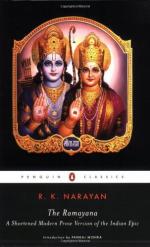|
This section contains 5,017 words (approx. 17 pages at 300 words per page) |

|
SOURCE: Sahai, S. “Sources of the Lao Ramayana Tradition.” Indian Horizons 21, nos. 2-3 (April-July 1972): 70-81.
In the following essay, Sahai compares Southeast Asian versions of the Ramayana with Valmiki's Indian text.
Constant and continuous cultural contacts from the first centuries of the Christian era created favourable circumstances in South East Asia for understanding and appreciation of Indian ideas and values as expressed through the classical works of literature. In literary works like the Ramayana and the Mahabharata, the people of South East Asia found indeed some fine human values similar to those which they cherished most. This would explain partly the rapidity with which the Ramayana, one of the most important Indian epics, became so popular in this part of Asia.1
As early as the seventh century A.D., the epigraphic texts of Cambodia make pointed references to the Ramayana.2 In the same epoch, an inscription of Champa...
|
This section contains 5,017 words (approx. 17 pages at 300 words per page) |

|


